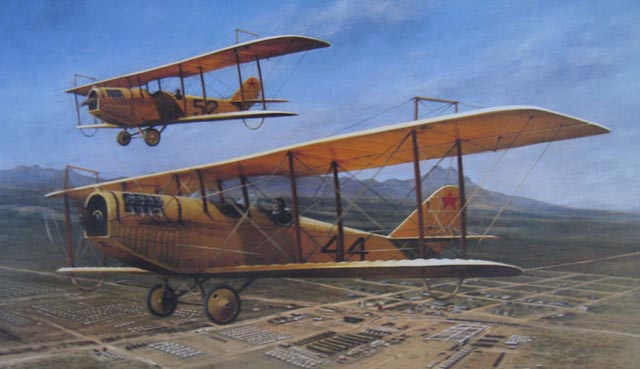
Artist Peter R. Westacott’s painting “ Cradle of American Air Power” depicts a pair of Curtiss biplanes over Columbus, N.M. Westacott donated use of the image to the First Aero Squadron Foundation, one of many contributions collected in an effort to restore the aerodrome. Image courtesy FASF.
The birthplace of American military aviation is today a nearly featureless swath of New Mexico desert where a donated windsock will be planted in time for an Oct. 6 dedication of a new runway. A group of aviators and history buffs have raised money to buy the land—donations from far and wide, none larger than $1,000—and bring an airport and its history back to life.
On this patch of desert, the U.S. Army Signal Corps 1st Aero Squadron deployed in 1916, responding within days to an attack by Pancho Villa on nearby Columbus, N.M. Gen. John “Black Jack” Pershing commanded soldiers and, for the first time, a small collection of Curtiss biplanes and freshly-trained pilots, who provided reconnaissance and communication with ground troops chasing Villa into Mexico. The nation’s entry into World War I cut short the effort to capture Villa, and the airfield went on to serve as an emergency landing strip on the early airline routes connecting San Diego and El Paso, Texas.
In the 1960s, former World War II bomber pilot Martin Willard Houltin led federal officials on a different kind of chase, credited by a former U.S. Customs agent as a pioneer in the use of small aircraft to smuggle marijuana by the ton from Mexico. Houltin based his “Columbus Air Force” at the airstrip that has been known as Columbus Municipal Airport in years past, and remains so in the FAA (and AOPA) databases, though the runway was overgrown with mesquite and creosote until recently. According to First Aero Squadron Foundation President Bill Wehner, one of the founding members of a nonprofit group dedicated to restoring the airport and teaching its history, flights in and out of the airport ended with the arrest of Houltin and his conspirators.
Hoiltin, who died in 1999, earned a measure of respect in local circles, excluding the Customs and Drug Enforcement Agency officials tasked with stopping him. Criminal defense attorney and former mayor of Columbus Carlos Ogden spoke to the Albuquerque Journal about Houltin and his fellow outlaw pilots in 1999:
"They were pioneers in their field,” Ogden told the newspaper. "They used to say Marty was a pilot's pilot. He was as good as you could get in small planes."
Columbus regained notoriety in 2011, this time with the mayor, police chief, and a third local official accused of running guns.
“It’s a busy little community,” Wehner said.
There’s no telling how busy the old airport will be on Oct. 6, with a donated windsock to be planted and about 2,600 feet of desert scraped clean for arrivals, an east-west runway marked by the absence of plant life. Wehner said transportation has been arranged from nearby airstrips, including nearby Deming Municipal, which affords luxuries including a pair of paved runways, fuel, maintenance, and instrument approaches. A few of the old taxiway lights, and an old foundation are among the relics that mark the site of the once-and-future aerodrome.
“It’s here, if you want to use it,” Wehner said.
The effort to restore the aerodrome—easily confused with a nearby gravel strip named in honor of the first Army squadron—began about four years ago, after Wehner, a volunteer for the local historical society, stumbled on the transcript of a local address by Jim Greenwood, an aviation legend in his own right credited with giving the Learjet its name while working for Bill Lear, and playing a prominent role with the FAA in its dealings with hijacker D.B. Cooper in 1971 (Greenwood was, among other things, a parachute expert). Greenwood in his previous visit had recalled the earliest days of military aviation, including the Army pilots who, in some cases, took their flight lessons from Orville Wright—by mail. Wehner tracked Greenwood down, and struck up a conversation.
“He agreed to be the first chair of our advisory board, it kind of went from there,” Wehner recalled. Greenwood died in 2011, though his daughter plans to attend the dedication and ribbon cutting (sign-ins begin at 9 a.m. in the Legion Hall, and the ribbon will be cut at 2 p.m.). Wehner, 77, doesn’t expect to live to see the foundation’s dream fully realized: building a modern airport, museum, and memorial. But with the support of many people, chipping in $5, $10, and $20 from far and wide, he is optimistic that a humble beginning, or re-beginning, will not be the end of this story.
“We’ve bladed open the runway, and we’ve bladed open a parking area,” Wehner said. “One of these days, we’ll get to installing tiedowns.”

